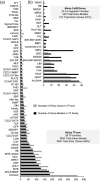The Maize TFome--development of a transcription factor open reading frame collection for functional genomics
- PMID: 25053252
- PMCID: PMC4283594
- DOI: 10.1111/tpj.12623
The Maize TFome--development of a transcription factor open reading frame collection for functional genomics
Abstract
Establishing the architecture of the gene regulatory networks (GRNs) responsible for controlling the transcription of all genes in an organism is a natural development that follows elucidation of the genome sequence. Reconstruction of the GRN requires the availability of a series of molecular tools and resources that so far have been limited to a few model organisms. One such resource consists of collections of transcription factor (TF) open reading frames (ORFs) cloned into vectors that facilitate easy expression in plants or microorganisms. In this study, we describe the development of a publicly available maize TF ORF collection (TFome) of 2034 clones corresponding to 2017 unique gene models in recombination-ready vectors that make possible the facile mobilization of the TF sequences into a number of different expression vectors. The collection also includes several hundred co-regulators (CoREGs), which we classified into well-defined families, and for which we propose here a standard nomenclature, as we have previously done for TFs. We describe the strategies employed to overcome the limitations associated with cloning ORFs from a genome that remains incompletely annotated, with a partial full-length cDNA set available, and with many TF/CoREG genes lacking experimental support. In many instances this required the combination of genome-wide expression data with gene synthesis approaches. The strategies developed will be valuable for developing similar resources for other agriculturally important plants. Information on all the clones generated is available through the GRASSIUS knowledgebase (http://grassius.org/).
Keywords: GRASSIUS; Zea mays; gene regulatory network; grasses; maize; recombination-ready; transcription factor; yeast one-hybrid; yeast two-hybrid.
© 2014 The Authors The Plant Journal published by Society for Experimental Biology and John Wiley & Sons Ltd.
Figures





References
-
- Barbazuk WB, Fu Y, McGinnis KM. Genome-wide analyses of alternative splicing in plants: opportunities and challenges. Genome Res. 2008;18:1381–1392. - PubMed
-
- Bharathan G, Janssen BJ, Kellogg EA, Sinha N. Phylogenetic relationships and evolution of the KNOTTED class of plant homeodomain proteins. Mol. Biol. Evol. 1999;16:553–563. - PubMed
Publication types
MeSH terms
Substances
LinkOut - more resources
Full Text Sources
Other Literature Sources
Research Materials
Miscellaneous

